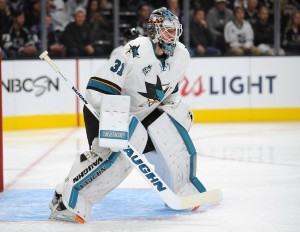Years ago, a business mentor of mine described two basic approaches a top executive can use when they allocate their time. They can weight their time to fix problems within the organization. Or they can weight their time to maximize the opportunities with things that are working well.
The difference in the approaches is simple: one seeks to minimize downsides and weaknesses, the other seeks to maximize upsides and strengths. Minimizing downside usually entails very specific, targeted actions. Maximizing upside often requires broad-based change across an organization.
Sometimes, there are elements of both. In last year’s Stanley Cup playoffs, the Chicago Blackhawks recognized deficiencies in their third defense pairing. So they greatly limited playing time for their bottom pair defensemen and rode their top two defensive pairs to a title. They addressed their weakness by maximizing one of their main strengths.
The Shark Path
In the final trading week of this NHL season, San Jose Sharks general manager Doug Wilson went the ‘minimize downside’ path. The Sharks roster had two notable challenges. The third pair, right-handed defenseman was smallish rookie Dylan DeMelo. DeMelo has come a long way in his rookie year, but the potential for him to be exposed was substantial (Matt Tennyson, the other candidate for that role was beaten out by DeMelo). Simply put, Wilson and head coach Peter DeBoer recognized that DeMelo would likely be in over his head come playoff time. So they acquired Roman Polak. It was targeted acquisition. Wilson said he was looking for a big, physical, veteran, right shot defenseman and that is what he got.

Over the course of this season, it became clear the Sharks were placing most of their goalie eggs in starter Martin Jones’ basket. The backup goalie for the Sharks was Alex Stalock. Often cited as a popular player in the locker room, Stalock simply was not getting the job done. Backup goalies sometimes play an important role in the playoffs and Wilson found one of the best in the business in James Reimer to replace Stalock. While I expect Jones to remain the starter, the Sharks have a genuine backup plan in case Jones struggles or is hurt.
The Sharks also added depth forward Nick Spaling. Spaling has never been much of a force. He is expected to compete with other Sharks forwards for a role on a third or fourth line. He added to the Sharks depth, offering a capable replacement in case of injury to a lower line forward. Importantly, the depth Spaling provided made it easier to trade forward Ben Smith to acquire Reimer.

All three Sharks moves can be put in the ‘minimize downside’ category. The major moves by the Sharks primary competitors in the Pacific Division fit a similar pattern. Anaheim added Adam Clendening, David Perron, Brendon Pirri and Jamie McGinn, all essentially depth players. The Kings acquired Kris Versteeg, also a useful depth player, addressing a roster weakened by injury. The Kings also added struggling defenseman Rob Scuderi to replace struggling defenseman Christian Ehrhoff.
The ‘minimize weakness’ strategy should allow San Jose, and others who took this approach, to use their entire roster. In theory, this means the team will spread minutes more evenly across the lineup. The benefits are greater flexibility in matchups and keeping players fresher over the course of each game and for each series. The theory makes sense. As a counterpoint to that theory, we have the Blackhawks Duncan Keith. He logged over 30 minutes per game over the course of last season’s playoffs on his way to a Conn Smythe and Stanley Cup. Staying fresher was not a requirement for him.
Best Players
It is oft said that in the playoffs, “you need your best players to be your best players”. ‘Best players’ can roughly be translated as the top third to top half of the roster. None of the Pacific Division leaders acquired a ‘best player’.


This contrasts with a pair of specific moves made in Western Conference’s other division. In the Central Division. Chicago reacquired Andrew Ladd. Ladd is a legit ‘move the needle’ player who can play top-tier minutes with top end linemates. Colorado added Mikkel Boedker, who can also be expected to fill a top six role for the Avalanche. These two can be considered ‘best players’. They move the needle in terms of teams high-end talent.
The Sharks’ Roman Polak acquisition, was driven by a GM wanting specific attributes to fill a very specific role. This differs from the Ladd and Boedker acquisitions, which were not driven by a specific need. Instead, they were driven by a desire to add higher end talent. Ladd and Boedker were not brought in to fix a problem, but to create upside opportunity.
Move the needle players create ripple effects throughout the lineup. Ladd and Boedker will likely mean personnel shuffling of most, if not all of the forward lines for their respective teams. Polak’s arrival, in contrast, forces no other lineup adjustments beyond swapping him into the lineup and taking DeMelo out of the lineup.
Teams trying to make a splash in the playoffs can minimize downside issues by filling holes. Alternatively, they can reach for upside by paying a larger price, bringing in higher-end talent and shuffling the deck. There is no rule that says you can not attempt both, though practical constraints exists, such as cap space and tradeable assets. Chicago and perhaps Colorado are the only teams that attempted to do both in the Western Conference.
The Pacific Division contenders all selected a similar path, to address weaknesses by upgrading the lower end of the roster. Two contenders in the Central selected a different path and added to the top end of the roster by adding ‘best players’.
Will the teams that paid for major upgrades be rewarded in the postseason? It will be interesting to see which approach provides the most benefit in this year’s Cup run.
Zeke’s Notes:
The Sharks are third in a tightly bunched race for the top spot in the Pacific Conference. They are close behind Anaheim and Los Angeles. The Sharks are also 14 points clear of Arizona and Vancouver, who sit in fourth and fifth place respectively in the Pacific Division. With the season now in the final quarter, the three California teams are essentially locked into a playoff spot. This is a time of year where many fans find themselves watching the scoreboard, often with several games a night having potential impact on their team’s playoff situation. Because of the wide gap in the standings and the declining play of the teams behind them, fans of California teams have very little need to scoreboard watch except for games involving California teams. Credit the recently changed playoff system. Under the prior system, only a 15 point gap separates the top record in the West from eighth place. The Sharks would be nine points back of the top Western teams with multiple games in hand, yet only six points clear of the nominal last seed. Under the old playoff selection system, Sharks, Kings and Ducks fans would be doing a lot more scoreboard watching.